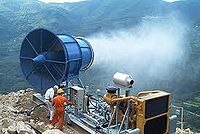Dust Suppression Systems
Dust is generated by wind erosion as well as by moving, crushing, grinding or milling materials to a finer size. It consists of solid particles larger than 1 micron (µm) in mean diameter. Particles less than 10 µm are the most dangerous, as these can enter the respiratory system and causebreathing difficulties.
Among basic methods to achieve dust control, wet dust-suppression spray systems increase humidity/moisture content in the product stream, helping to minimise dust overall and prevent it from becoming airborne. Moisture can be added to the material when it is stationary or moving. Such systems use nozzles that produce drops in the 100 to 250 µm range to create a fine drizzle effect.
By contrast, airborne dust-capture spray systems produce very fine water drops to collide with dust particles in the air, forming agglomerates of dust and water too heavy to remain airborne. Water droplets that are too large will not collide with the finest, most hazardous dust particles and droplets that are too small evaporate quickly and release the captured dust. Nozzles that produce a fine mist consisting of droplets in the 20 to 100 µm range or a fine drizzle consisting of droplets in the 100 to 250 µm range are most effective. Collision is most likely to occur when the drops and dust particles are similar in size.
In addition to droplet size, effective spray system performance and dust suppression depend upon such spray characteristics as drop distribution, drop velocity, spray pattern and spray pressure.
Spraying dust with liquid adds weight to the particulate matter and prevents it from becoming airborne or settles it quickly, if already airborne. Adding moisture to dust and materials during processing also helps minimise the amount of dust produced downstream.
Related Video
